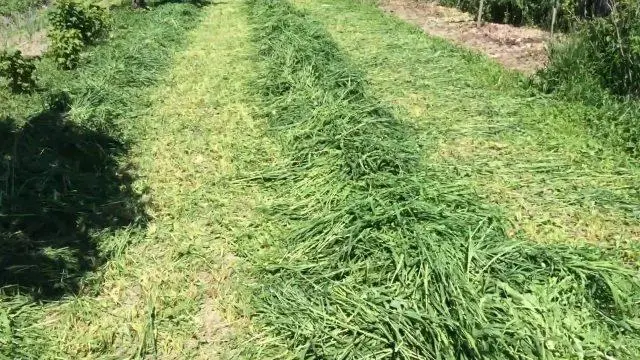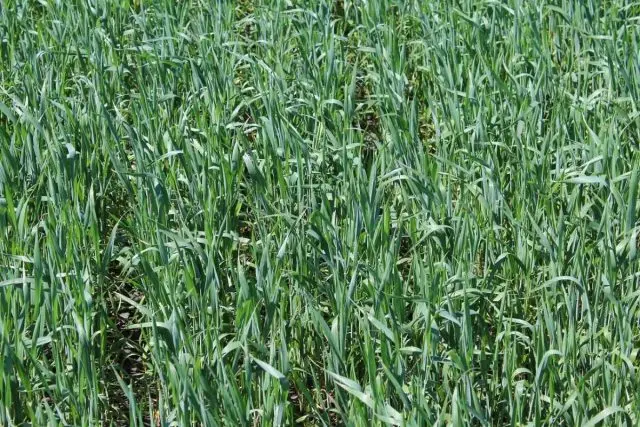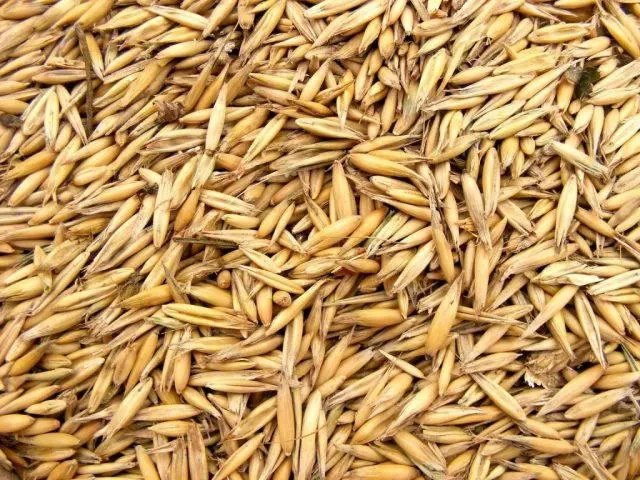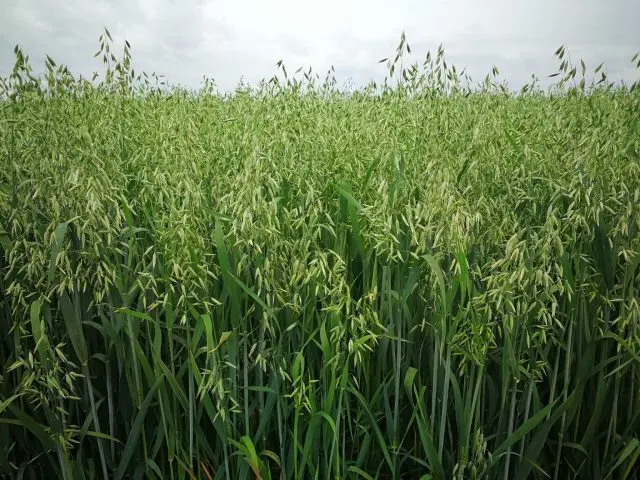Contents
Barley as green manure is often used by summer residents and farmers because of a number of its positive qualities. This is an unpretentious cereal plant, which has a high nutritional value for the earth. If you plant in time, and then plant this crop in the ground, you can get an excellent natural fertilizer.

Barley saturates the soil with useful macro- and microelements
Is barley green manure
When asked whether barley is green manure, experts unequivocally give a positive answer. Despite the fact that this plant is usually grown as a grain crop for brewing, producing cereals and as livestock feed, it is also used as a green manure, and along with oats, rye and other cereals. In addition, compared to them, it has a high resistance to drought as well as cold.
There are two types of barley – spring and winter, and both are used for vegetable garden green manure. Only the first variety is planted in the spring and mowed before planting the main crops, and the second is sown in the fall before winter.

Barley 100% meets the requirements for green manure
Pros and cons of barley as green manure
Cereal as a green manure has a huge number of advantages, compared with minor disadvantages.

The crop is best for planting in areas where there is a long period of drought
Advantages:
- releases a large amount of useful substances during decay;
- accelerates growth, increases productivity, improves fruiting of crops;
- improves the quality of vegetables and fruits;
- produces nutrients in an easily digestible form;
- helps the soil to become loose and light;
- structures the earth;
- creates conditions for good soil absorption of air and moisture;
- displaces weeds;
- disinfects the area;
- resistant to frost and drought;
- grows rapidly and gains green mass;
- reduces the number of harmful insects.
Disadvantages:
- barley roots are attracted to wireworm beds;
- culture does not grow well on acidic soil.
What soils are used
Barley feels great and shows positive qualities on different types of soil: heavy, dense, sandy, loamy. The only condition that should be taken into account when planting green manure is that if the earth has high acidity, it must first be deoxidized with dolomite flour or ash.
If we talk about varieties of crops, it should be noted that winter barley is more recommended for areas prone to erosion and weathering, and it is preferable to plant spring barley in warm regions.
What crops are suitable for
As green manure, barley is suitable for various vegetable crops. It serves as the best predecessor for:
- potatoes;
- zucchini and cucumbers;
- tomatoes;
- Pumpkins
- legumes;
- pepper;
- beets;
- carrots;
- radishes, radishes and turnips.
In addition to vegetables, cereal is a good green manure for garden plants: grapes, currants, blackberries and raspberries.
When to sow barley as green manure
In order for the green manure to bring the maximum effect, it is important to choose the optimal time for planting it. It is this moment that will guarantee that barley will accumulate nutrients and develop well.
Usually choose one of three options for sowing crops:
- Spring. Siderate is sown with the arrival of the first warm days, as soon as the snow melts. With this option, the earth is well saturated with melt water, the seedlings sprout together and grow quickly. Usually, the period of spring planting of a crop depends on the region of cultivation and can be done both in the second half of March and at the end of April.
- Summer. Summer sowing of barley is carried out towards the end of the season, after harvesting. In this case, the gardener will have to provide the plantings with regular watering, especially at the initial stage of growth.
- Autumn. Starting from the last days of August and ending with the second half of September, gardeners start planting winter barley. The period should be such that the plant does not have time to become tall and starts active growth only in the spring.

Most often, barley as green manure is planted at the end of the summer season.
Landing technology
The technology for planting barley does not cause any particular difficulties for vegetable growers, and if you follow the recommendations of experts, then the culture will give friendly shoots and bring many benefits.
Green manure should be planted in loosened soil, but in the case of dense soil, it is advisable to first dig it onto a shovel bayonet. If the land on the site is light, then it is dug up to a depth of about 15 cm.
Beds for barley are prepared in advance, a couple of weeks before planting. Fertilizers are added to depleted soil in the form of manure or a complex composition.
On the day of sowing, if necessary, the beds are moistened and after the water is absorbed, proceed to the procedure. The crop is sown in furrows with a depth of 3 cm (heavy soil) to 5 cm (light soil), which are located close to each other, at a distance of up to 7 cm. The gap between the seedlings in a row should be a maximum of 2 cm. Then the plantings are sprinkled with earth and tamped .

Barley seeds are large and easy to sow
Care instructions
Barley is a picky culture, does not require special attention and, in favorable conditions, grows well on its own. In warm weather, seedlings of the crop may appear as early as the fifth day after planting.
If the street is hot and dry, then, despite the drought tolerance of barley, it will need to be watered at least once a week.
To create more favorable conditions for the growth of young barley, the beds with it can be loosened several times and, if necessary, weeded.
When grown on a site that has completely lost fertility, it is allowed to feed the crop once. Why is it enough to sprinkle the bed with ordinary saltpeter, which will help barley grow faster. It is necessary to apply the composition in a dry form, only on well-moistened soil.
Mowing and embedding into the soil
Barley harvesting is usually organized 10-15 days before the proposed planting of crops. The main thing is not to be late and carry out mowing before spikelets appear on the shoots. Otherwise, the greens will become tough, and it will take much longer for them to turn into healthy humus, in addition, their nutrient content will decrease significantly.
Sideration can be done in two ways:
- Surface. The easiest way is to cut the barley obliquely or with a flat cutter, then evenly distribute the aerial part throughout the site. In order for the stems to more actively release useful elements and decompose faster, it is allowed to grind them first. With this method of fertilization, barley will gradually rot and saturate the soil, and will also become an effective mulch layer that protects plants planted between decomposed cereals from the hot sun.
- Embedding in the soil. In the case when there is time before planting crops (1-2 weeks), fertilization of the site can be carried out using the incorporation method. To do this, barley is mowed in the usual way, then laid out on the surface of the soil and allowed to dry. Next, carry out the termination using a flat cutter or chopper. In this case, a shovel is not used, since during the procedure the green mass should remain in the upper soil layer.
In the case when there were too many green manures, and it was not possible to use them all, you can prepare an excellent top dressing based on the leftovers. To do this, chop the greens, pour it with water in equal proportions and insist for seven days in the sun, sometimes stirring. Before use, strain and dilute with water in a ratio of 1: 1, apply once every half a month.

Some gardeners mow barley in the fall, but in this case it gives a less pronounced effect.
Conclusion
Barley as green manure has proven itself in horticulture. It is successfully used to enrich the soil, control weeds and pests. This culture has a number of advantages, and due to its unpretentiousness and ease of planting and care, it does not require special knowledge in agricultural technology from the gardener.
Growing barley as green manure eliminates the use of purchased nutrients.










Poate afli cum arat orzul.